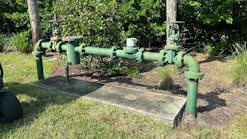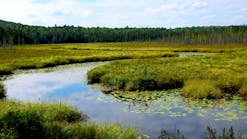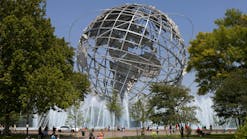MMSD itself has undertaken several techniques to try and showcase stormwater control methods. The first–and most visible–was the installation of an underground stormwater treatment system at a coffee shop and education center MMSD opened along the Milwaukee side of Lake Michigan in 2002. This system effectively is reducing a broad range of pollutants that drain from the parking lot, including bacteria, petroleum hydrocarbons, metals, and nutrients.The coffee shop is located along the heavily traveled Lake Drive and has hosted several meetings of community and municipal officials to view the system, a StormTreat device purchased through Eco-Cycle Inc. of Manchester, ME. “We are trying to use it as a model to show communities how they can do stormwater management as part of smaller developments,” Shafer says. “We’ve had a lot of interest from the communities we serve who are looking for innovative stormwater control methods to show to developers who come to them and say they can’t do stormwater control with their new project.”The system is centered within a small wetland fringed with plants designed to filter runoff from the property’s parking lot. It is intended to capture and treat all runoff from small storms and first-flush runoff from large storms.The system uses a multistage total suspended solids removal system to treat the runoff before infiltration. A grit filter bag is used to trap the larger floatables that find their way past the catch basin preceding the unit. The system also includes a series of sedimentation chambers fitted with skimmers and a gravel filter that serves as a substrate for constructed wetlands.Treated stormwater is infiltrated into the 0.75-in. stone used for backfill in the excavation around and under the StormTreat tanks. The stone is highly permeable and transmits the treated water downward until it encounters the parent soils. During heavy rains, the infiltration rate exceeds the permeability of the parent soils, and the stone backfill area serves as a temporary storage reservoir.“It is the hope of all involved that this project will be a model for what’s possible,” says Sheila Charnon, MMSD’s project manager. “Few public sites exist in greater Milwaukee that clearly demonstrate the values of what [effects] good “˜green’ building practices can have on the water environment. The goal in going green on the [project] was to show citizens how to reduce the impact of construction on the environment while still being able to maintain a building’s beauty and highlighting its historic features.”Green Roofs
MMSD has also installed a green roof on its four-story headquarters building near downtown Milwaukee. One of the first green roofs in southeastern Wisconsin, it consists of 435 containers holding manmade growing material and dry prairie plant species native to the region. The containers, which measure 2 x 4 ft. and are 4 in. deep, cover about one-third of the building’s 11,000-ft.2 roof. Each holds about eight plants that will grow to between 12 and 16 in. The green roof also features a walkway built of recycled materials. Steve McCarthy, MMSD’s project manager, notes that the district’s project is mainly designed to demonstrate how much rainwater and polluted runoff it can keep out of the sewer system and the rivers. By mimicking natural drainage processes, green roofs can achieve runoff characteristics similar to open-space conditions and can reduce runoff volumes by 15–90%. Other benefits of green roofs include aesthetics and reduced energy costs and urban temperatures. “What makes the district’s green roof unique is the native species of grasses and flowering plants we’ve selected and that they’re growing in only 4 inches of material,” McCarthy says. Other green-roof systems involve installation of a waterproof membrane followed by layers of insulation, drainage filter, soil, and plantings. The district selected what’s known as a “Green Grid” container system because of its easy installation, use of recycled plastics, and ability to be rearranged as needed. Roy F. Weston Inc. of Chicago, IL, performed the installation. The green-roof project cost just more than $69,000.McCarthy is adding native, dry prairie seeds to the containers to see how well they grow over a period of time. Plants growing on dry bluffs along the Mississippi River in southwestern Wisconsin served as a natural model for species selection, he says. Plantings indigenous to Wisconsin were selected for their ability to withstand the hot and dry summer conditions and other seasonal variations typical of roof installations.McCarthy says the plantings are expected to provide other advantages:A waterproof sheet between the roof and the planters should reduce the wear and tear on the roof, resulting in fewer costly roof repairs.Because the plants are in modular containers, they can be moved if there is a need to repair a leak. If the green roof catches on in the area, it could lower nearby temperatures with its cooling effect. Because of the urban heat island effect, cities are generally several degrees warmer than areas that have foliage. The plants might scare off seagulls, which generally don’t like grassy areas because predators might be lurking there. Common in Europe for the past several decades, the green roof has been taking off slowly in the United States. Chicago City Hall got considerable kudos for its green roof installed in 2001, but there are other examples, including the Oaklyn Branch Library in Evansville, IN, and the Yorktown Square condominium project in Fairfax, VA, McCarthy notes. In addition, Ford Motor Company is building a 500,000-ft.2 green roof at its Rouge River assembly plant in Dearborn, MI, billed as the largest living roof in the world.One reason building owners are reluctant to build green roofs is a fear that the weight could prove to be too much for the structures. McCarthy says the MMSD project adds only 15 lb./ft.2, well below what most buildings can hold. Even at Chicago City Hall, where the “soil” depth ranges from a few inches to a couple of feet and the plants range from grasses to trees, the maximum weight is only 30 lb./ft.2The green-roof project is part of the district’s Best Management Practices initiative. Shafer launched the initiative as a way to help communities prevent future flooding. The program looks at various methods to reduce or delay the volume of stormwater that can overwhelm the sewer system during periods of heavy rain and contribute to sewer overflows and flooding.Under the initiative, MMSD provided $454,000 to eight businesses and governments to undertake demonstration projects in the Milwaukee area to highlight the benefits of stormwater best management practices (BMPs) that manage volume, rate, and quality of stormwater runoff.Two additional green roofs are being undertaken as part of the initiative. The University of Wisconsin-Milwaukee’s Great Lakes Water Institute is converting about 10,000 ft.2 of its first-floor roof to a vegetated green roof, with an accompanying graywater irrigation system. The agency received $110,000 from MMSD for its project.“We believe that the only limitation for the use of green roofs in our urban areas is education: few people are aware that green roofs are a feasible roofing option,” the agency states in its proposal. “The green roof will serve as an educational demonstration both during construction and when completed in order to establish a local base of knowledge for green roof implementation.”The agency will monitor the green roof and an adjacent unconverted roof for temperature, precipitation, runoff volume, and bacterial water-quality indicators, comparing the results to five asphalt roofs in downtown Milwaukee.In addition, the Urban Ecology Center, a Milwaukee community center, is installing a green roof as part of its new accessible garage roof. The garage is part of a new sustainable, or green, building the group is constructing. The center is receiving $40,000 from MMSD.Pervious Concrete
The most watched BMP project, however, was the first implementation in the Milwaukee area of pervious concrete, which MMSD did at the coffee shop site. In mid-2003, MMSD installed pervious concrete in a portion of the parking lot to see how it would work in a winter climate.Shafer says the biggest problem with standard pavement is it doesn’t allow water to soak into the ground naturally, where it is cleaned and purified. Instead massive amounts of rainwater and melting snow flow over paved surfaces, collecting everything from engine oil, transmission fluid, and metals to bacteria, garbage, and more. Porous pavement reduces and slows runoff. Made from concrete, with solid areas that surround smaller open areas, it allows water to infiltrate the ground. Asphalt porous pavement appears to be one solid surface, but it acts like a sponge. It uses less tar and fewer small particles to create tiny holes in the pavement for draining water. The first commercial use of the pervious concrete in the Milwaukee area is part of the development of an ice cream and donut shop in Oak Creek, a southern suburb of Milwaukee. Zabest Commercial Group Inc. is including the 0.54-ac. pervious parking lot as part of its 1.23-ac. Dunkin’ Donuts and Baskin-Robbins development.To help fund the project, Zabest and the City of Oak Creek received $79,900 from MMSD. As part of the grant, Zabest has agreed to monitor the effectiveness of the concrete for one year and prepare a final report, fact sheet, and PowerPoint presentation on its effectiveness.Steve Nikolas, president of Zabest, says the use of the pavement was much more cost-effective than purchasing the land necessary for stormwater detention ponds and then building them. “The incremental cost to acquire additional land to accommodate the above grade stormwater retention, or the costs associated with the underground storage of stormwater, may make such development economically unfeasible,” Zabest wrote in its grant proposal to MMSD. “Unlike large parcels where these costs can be spread across the development and pass through to many end users to defray the financial impact, the smaller parcel developments are unable to do so and face a difficult financial obstacle. In many cases, it will preclude development.”In fact, Nikolas estimates that the cost to accommodate underground storage for a 1- to 5-ac. development could be as high as $400,000. Similarly, he says, the cost to purchase an adjacent parcel to accommodate a stormwater detention pond could range from $85,000 to $350,000. “These small parcel developments often do not provide the income to support these incremental costs,” he notes.Nikolas says Zabest agreed to include the pervious pavement in the development because of frustrations with other stormwater management techniques. As part of its recent 35,000-ft.2 retail development on East Capitol Drive in Milwaukee, the developer had to include 2,100 lin. ft. of 12-in. pipe under the parking lot to collect and store runoff. “We decided there had to be a better and more cost-effective way to deal with stormwater,” he says.Although pervious pavement has been used frequently in Florida, Texas, and California, there have been concerns about its uses in cold-weather climates, such as Wisconsin. But Nikolas found that its use in the early 1990s in several developments in Sweden, which he says has a climate similar to Wisconsin, proved to engineers that it could handle freezing temperatures and freeze/thaw cycles. The pavement used in this case is developed by Ecocreto of Texas Inc. The developer will incorporate several features to deal with cold-weather concerns:Installation is in a low-traffic area that will be used only for parking and access.Special care will be taken during construction to avoid clogging the pavement, and stormwater runoff will be diverted away from the planned pavement area to further prevent clogging. The pavement will be immediately covered after construction, and no vehicular traffic will be allowed on it for at least seven days after installation.The installation will include design features in the subgrade to prevent frost heave.Regular maintenance of the pavement, including regular vacuum sweeping and high-pressure washing, will be used to remove any particles.A snow removal plan will be implemented but will not include sand, which can clog the porous spaces. A designated snow management area on the property will eliminate the need to store snow piles on the pavement.“The research has shown it should be effective in this climate, and we are confident it will work,” states Nikolas. At peak efficiency, the concrete can handle rain up to 4 in./min., he says, adding that even at 60% efficiency, it can handle rain up to 4 in./hr., or the equivalent of a 100-year storm.City officials will be closely monitoring the project to see if it works and thus can be used by future developments in Oak Creek. “This is not typical stormwater practice, but if it works, I think it has great merit,” says Doug Seymour, director of community development for Oak Creek.The project will also include three rooftop rain gardens, with a combined area of 775 ft.2, or one-third of the contributing rooftop area.
StormTreat System near Lake MichiganOther Demonstration Projects
Additional BMPs and demonstration projects are being undertaken in Milwaukee. A project to install rain gardens at 17 local automotive recycling facilities received $60,500 from MMSD. The project will demonstrate the application and benefits of installing rain gardens in industrial and commercial settings. The rain gardens will be installed at roof downspouts and engineered to promote infiltration and plants’ uptake of relatively clean rooftop runoff.“Together with existing best management practices implemented by auto recyclers, rain gardens will become part of an integrated stormwater management approach that addresses both water quantity and water quality,” the Automotive Recyclers Cooperative Compliance Program states in its proposal. “These innovative landscape features will help reduce stormwater flow to MMSD’s conveyance and treatment systems and to Milwaukee’s waterways, create industrial sites that are more attractive places to work, and contribute to improved urban ecological health.”Adds Roger Bannerman of the Wisconsin Department of Natural Resources, “Rain gardens are something you can do to reduce runoff and replenish groundwater–they not only help solve the environmental problems, but they improve the aesthetics of your yard, they can attract wildlife, and they’re fun.”Another demonstration project is the incorporation of low-impact development techniques in the site design of the proposed $10 million African American World Culture Center being built in central Milwaukee. The project, which received $44,610 from MMSD, will include a rain garden, grassed swales, a wetlands system, and pavement management techniques to reduce runoff.Low-impact development design seeks to mimic the natural hydrologic response of undeveloped landscape, using a variety of strategies that integrate natural green spaces with onsite storage. “[The] facility will serve as a living environmental science laboratory that can be used to develop lesson plans and teach children and adults about the benefits of using innovative water-resource practices,” William Farmer, a Milwaukee engineer, states in the group’s proposal.The restoration and enlargement of degraded wetlands along Trinity Creek in Mequon, WI, is another ongoing project. The wetland system is designed to provide additional floodwater storage, improve water quality, and provide a northern pike spawning habitat. This project received $27,462 from MMSD.In a rain barrel demonstration project, the Milwaukee Community Service Corps will assemble rain barrels, educate property owners about their use, and conduct demonstration installations in 16 family developments of the Housing Authority of the City of Milwaukee. Rain barrels collect and store rainwater from rooftops to use later for lawn and garden watering. Within the combined sewer area of the City of Milwaukee, water collected in the rain barrels normally would flow through the downspout, onto a paved surface, and into a combined sewer.
And finally, the City of Milwaukee, through its Redevelopment Authority, received $60,061 from MMSD to develop site plans for a stormwater park as part of its redevelopment of Menomonee Valley, an old industrial area near downtown Milwaukee. The park will manage stormwater to improve water quality as well as volume of runoff. The project includes funding for the planning and design phase and for developing and implementing an educational and outreach component.“We are excited about these projects because we are confident the results will show that they can be used in the Milwaukee area,” Shafer says. “We are also very pleased with the enthusiasm shown to try new things for Milwaukee to benefit the residents of this area and reduce the risk of future flooding. The purpose of all of this is also to show the individual property owners that they can help reduce flooding and basement backups by just doing some common sense improvements.”





